
The Baju Empurau (also known in English language as "war jacket") is an armour from Indonesia.

The Baju Empurau (also known in English language as "war jacket") is an armour from Indonesia.
The Baju Empurau is a kind of armor that is made of materials found in nature. It consists of fish scales and tree bark. The larger fish scales are attached to the lower vest with split rattan fibers, the smaller ones with a fixed string made from plant fibers. The lower vest consists of interwoven layers of tree bark. The vest has no sleeves, no collar and is provided with a semicircular shape in the neck area, which serves to protect the neck from blows. It is used by the Sea Dayak ethnic group. [1]

Jayapura is the capital and largest city of the Indonesian province of Papua. It is situated on the northern coast of New Guinea island and covers an area of 940.0 km2 (362.9 sq mi). The city borders the Pacific Ocean and Yos Sudarso Bay to the north, the sovereign state of Papua New Guinea to the east, Keerom Regency to the south, and Jayapura Regency to the west.

Scale armour is an early form of armour consisting of many individual small armour scales (plates) of various shapes attached to each other and to a backing of cloth or leather in overlapping rows. Scale armour was worn by warriors of many different cultures as well as their horses. The material used to make the scales varied and included bronze, iron, steel, rawhide, leather, cuir bouilli, seeds, horn, or pangolin scales. The variations are primarily the result of material availability.

A kebaya is an upper garment traditionally worn by women in Southeast Asia, notably in Indonesia, Malaysia, Brunei, and Singapore. Outside of Southeast Asia, it is worn by Javanese, Malays and Portuguese Eurasians in Australian Cocos Islands and Christmas Island, coastal India and Sri Lanka, Macau as well as South Africa.
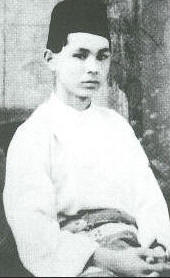
Baju Melayu is a traditional Malay costume, originated from the court of Malacca Sultanate and is traditionally worn by men in Brunei, Malaysia, Singapore, parts of Indonesia, southern Philippines, and southern Thailand. It literally translates as Malay dress and consists of two main parts. The first being the baju itself which has a raised stiff collar known as the cekak musang collar. The second part is the trousers called seluar. The two parts are made out of the same type of fabric which is usually cotton, or a mixture of polyester and cotton. A skirt-type adornment is also commonly worn with the Baju Melayu, which is either the kain samping, made out of songket, tenun cloth or the kain sarung, made out of cotton or a polyester mix. Both are loops of fabric that are folded around the wearer's waist. Jet-black or dark-colored headgear called the songkok can also worn to complete the attire.
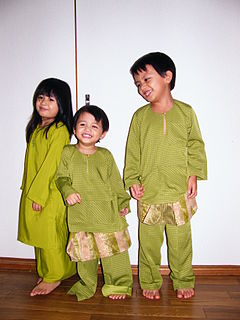
Pakaian is the term for clothing in Malaysia's national language. It is referring to things to wear such as shirts, pants, shoes etc. Since Malaysia is a multicultural nation: Malay, Chinese, Indian and hundred of other indigenous groups of Malay peninsula and Borneo, each has its own traditional and religious articles of clothing all of which are gender-specific and may be adapted to local influences and conditions. Previously, traditional clothes were worn daily. However, by excluding Baju Melayu, Baju Kurung and Baju Kebaya, many are now only worn on special occasions such as marriage ceremonies and cultural events.

Baju Kurung is a traditional costume of Malays and traditionally worn by women in Brunei, Indonesia, Malaysia, Singapore and southern Thailand. This type of traditional costume is the national dress of Brunei and Malaysia. In Indonesia, it is also one of the regional dresses, seen most on the island of Sumatra, where many ethnic Malay and Minangkabau women wear it.

The national costume of Indonesia is the national costume that represents the Republic of Indonesia. It is derived from Indonesian culture and Indonesian traditional textile traditions. Today the most widely recognized Indonesian national costumes include batik and kebaya, although originally those costumes mainly belong within the island of Java and Bali, most prominently within Javanese, Sundanese and Balinese culture. Since Java has been the political and population center of Indonesia, folk costume from the island has become elevated into national status.

Kemben is an Indonesian female torso wrap historically common in Java, Bali, and other part of Indonesian archipelago. It is made by wrapping a piece of kain (clothes), either plain, batik printed, velvet, or any type of fabrics, covering the chest wrapped around the woman's torso.
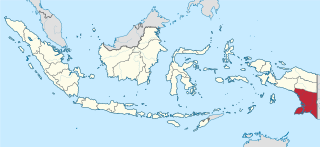
South Papua, officially the South Papua Province, is an Indonesian province located in the southern portion of Papua, which follows the borders of Papuan customary region of Anim Ha. Formally established on 25 July 2022 and including the four most southern regencies that were previously part of the province of Papua and before 2002 were part of Merauke Regency, it covers an area of 127,280.69 km2 and had a population of 517,623 according to the official estimates for mid 2021.

The Baju Lamina is a mail and plate armor from the Nusantara archipelago.
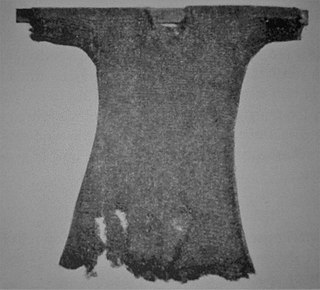
The Baju Rantai is a type of armor from Nusantara archipelago.
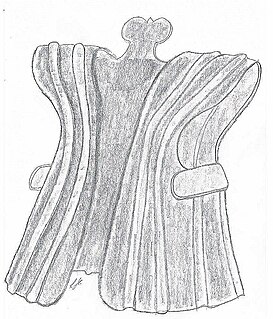
Baru Öröba is a traditional armor of the Nias people in Indonesia. The earliest examples of this type of armor were made out of crocodile skin. After crocodile can no longer be found on Nias, the material is replaced with hammered metal.

The BaruLema'a is a traditional armor from Indonesia.

The bodo blouse, locally known as Baju Bodo, is a sheer and transparent short sleeved loose blouse, a traditional costume for women of the Bugis and Makassar peoples of South Sulawesi, Indonesia. A bodo blouse is traditionally combined with a matching woven sarong that covered the waist below the body.

Tenun is an artful Indonesian technique of making a fabric by weaving different colours of threads. Tenun belongs to one of the typical Indonesian cultural arts produced by hand skills using traditional looms. The word Tenun itself has a high meaning, historical value, and technique in terms of colors, motifs, and types of materials and threads used and each region has its own characteristics. In addition, Tenun is also one of Indonesia's original cultural heritages that is still maintained and preserved to this day.

Highland Papua is a province of Indonesia, which roughly follows the borders of Papuan customary region of Lano-Pago shortened to La Pago. It covers an area of 69,685.31 km2 and had a population of 1,408,641 according to the official estimates as at mid 2021.

Karambalangan is a type of personal armor from Java. It is a metal coating worn in front of the chest or breastplate.

Kawaca is a term for war attire mentioned in Old Javanese texts. Its name comes from the Sanskrit kawaca which means armor, cuirass, a type of chain mail, any kind of cover, corset, jacket.

Siping-siping, simping-simping, or sisimping, is a type of armor used in Java. It is a short sleeveless jacket made of scale-shaped metal plates.